
Which one would we choose?
Our choice: Sonic toothbrushes
The vast majority of electric toothbrushes available today are considered 'sonic' electric toothbrushes.
They usually have dentist recommended features, clean the teeth well, are affordable and easy to source.
Sonic brushes were introduced by 'Sonicare', a company now owned by Philips. These have been popularised under the brand 'Philips Sonicare'.
'Ultrasonic' toothbrushes sound similar but are technically different.
Unlike sonic toothbrushes, ultrasonic models don't rely on a physical motion to clean the teeth.
Only a few truly ultrasonic brushes exist, and those that do tend to be very expensive.
There is limited evidence to support the use of ultrasonic toothbrushes instead of sonic toothbrushes.
Our in-house dentist Dr Gemma Wheeler does not recommend using them on a daily basis because they cannot remove all plaque from the teeth.
It's common for the word ultrasonic to be used incorrectly to describe what is actually a sonic toothbrush. We have noticed this in the marketing language of various sonic toothbrushes.
We recommend sonic toothbrushes. Our top choices are listed in the table below.
If you want a truly ultrasonic brush or want to know how they differ, read on.
Our main electric toothbrush recommendations
What's the difference between a sonic and ultrasonic electric toothbrush?
The fundamental difference between these two types of brushes is that sonic toothbrushes rely on a physical motion to clean the teeth, whereas ultrasonic brushes do not. Ultrasonic toothbrushes clean using hydrodynamic forces. Some use a combination of ultrasonic and sonic technology to remove plaque.
Many of the brushes we review and cover here at Electric Teeth are sonic, such as those from Oral-B and Philips.
However, Ultrasonic is another type of brush you could consider.
These are rarer to come across, but they are still available on eBay.
In this article, we'll be taking a look at the key differences between the two types of brush. We've included an infographic further down showing the two side by side.
If you are looking for an overview of the current range, you may like to see our best electric toothbrush post.
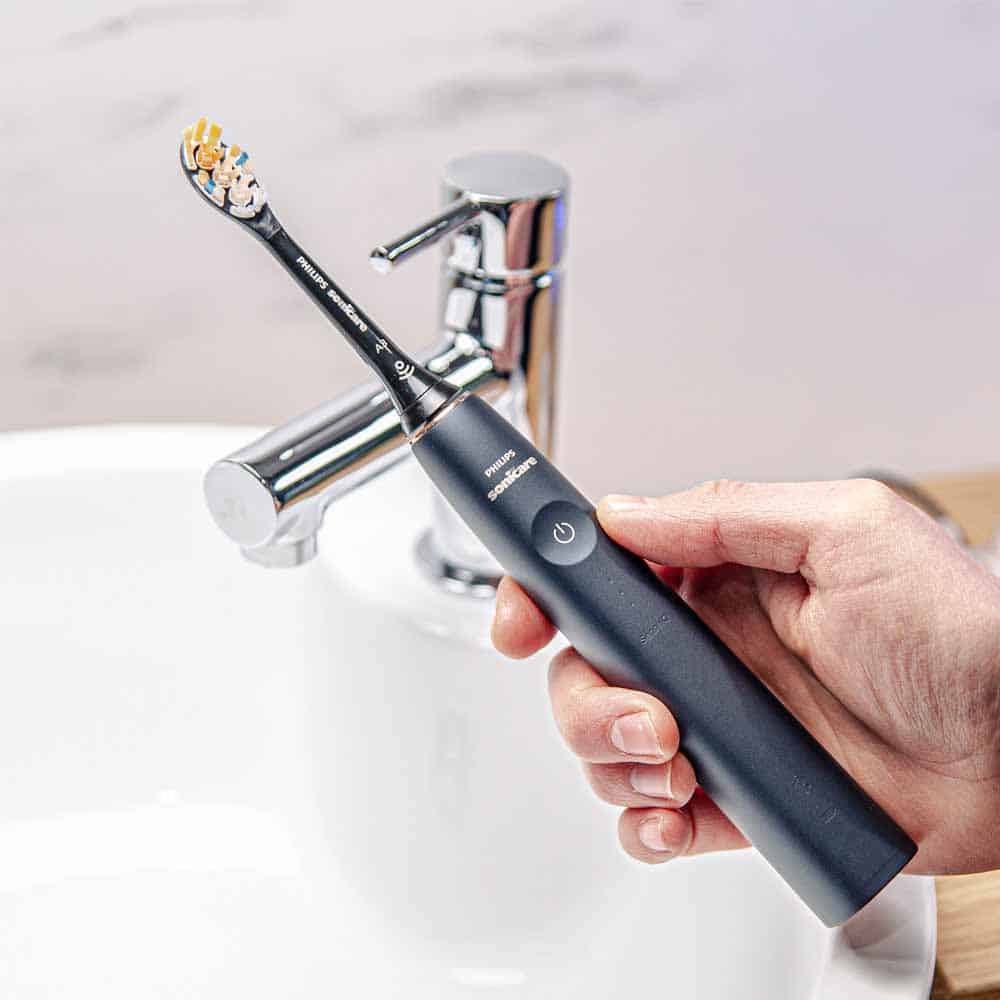
Sonic electric toothbrushes
To be classified as a sonic toothbrush, the motion or vibration from the brush has to be quick enough to produce a ‘humming’ sound that is within the audible range of the human ear (20 Hz to 20,000 Hz).
Sonic brushes typically offer 12,000-24,000 oscillations or 24,000-48,000 movements per minute.
Sonic brushes rely on a sweeping motion alone to clean the teeth, the movement that they provide is often high in amplitude which means they offer larger sweeping brush stroke motions.
It is the bristles on the brush head that move at this speed to essentially brush away food particles and bacteria that sit on the teeth and gum line.
As it does this, the sonic motor inside the brushes creates a sound that is audible to the human ear.
Examples of a sonic brush include Philips Sonicare, Colgate, Ordo, Spotlight Oral Care, Fairywill, SURI, Curaprox, Oclean and many more. We look at these brushes in detail in our electric toothbrush reviews.
The vibrations the bristles make do cause disruption of plaque beyond the tips of the bristles without the bristles actually touching that area.
It is thought that very high frequencies cause liquids to move and create “hydrodynamic forces” which damage the plaque layer in hard to reach areas (1).
The following diagram from the National Library of Medicine provides a visual representation of this:
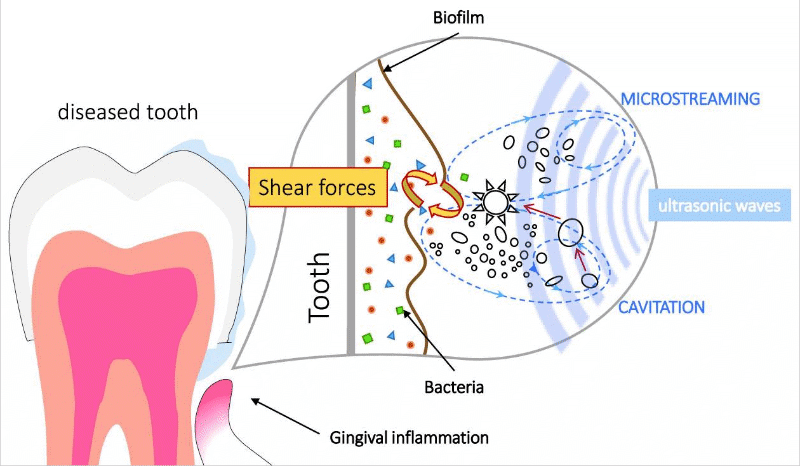
This secondary effect is actually the ultrasonic effect. This happens in many sonic toothbrushes and is beneficial to your oral health.
Sonic toothbrushes (with ultrasonic effects) should not be confused with ultrasonic toothbrushes. They are different.
Ultrasonic toothbrushes use only the very high frequencies, which you cannot hear. Ultrasonic toothbrushes clean using only hydrodynamic forces, and do not have a mechanical cleaning effect.
That said, often unintentionally, the word ultrasonic is used to describe products which use sonic frequencies too. Rarely are brushes truly ultrasonic. Be wary if a toothbrush is labelled as such.
As we shall explain, ultrasonic brushes operate at a much higher frequency and use ultrasound rather than the motion of the brush head to remove debris and bacteria. They can be silent too.
Ultrasonic electric toothbrushes
Ultrasonic toothbrushes, unlike sonic ones, do not rely on a physical motion to clean the teeth.
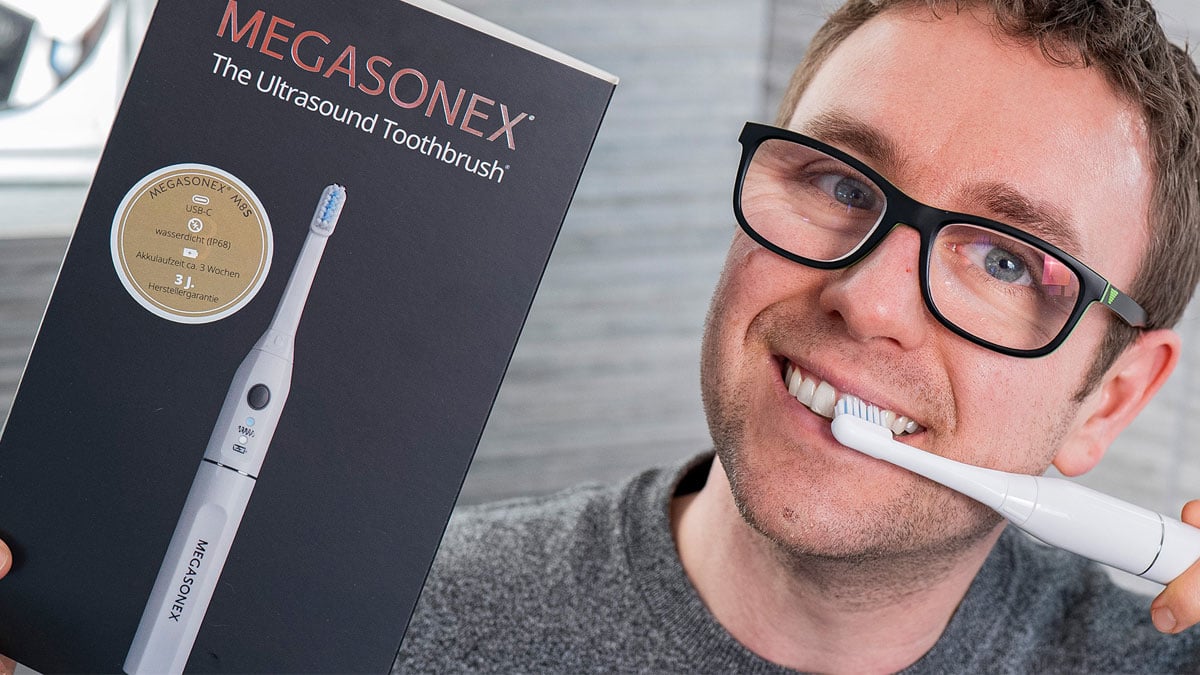
An ultrasonic toothbrush is one that uses a very high frequency of vibration referred to as ultrasound to remove plaque and bacteria from the teeth.
To be classified as such, the brush has to emit a wave of at least 20,000Hz or 2,400,000 movements per minute, considerably more than the very popular sonic technology.
This frequency is too high to be heard by the human ear. It is ultrasonic.
Within the USA, the Food and Drug Association (FDA) actually specify a minimum of 1.6MHz or 192,000,000 movements per minute.
These high frequency waves are also low in amplitude. They can damage the bonds between bacteria, without a bristle physically touching the area.
The overall effect is that the bacterial chains found in the mouth that make up plaque are broken up by the vibrations and can work as far as 5mm below the gumline.
Essentially speaking the brush can clean the teeth simply by resting the brush on it.
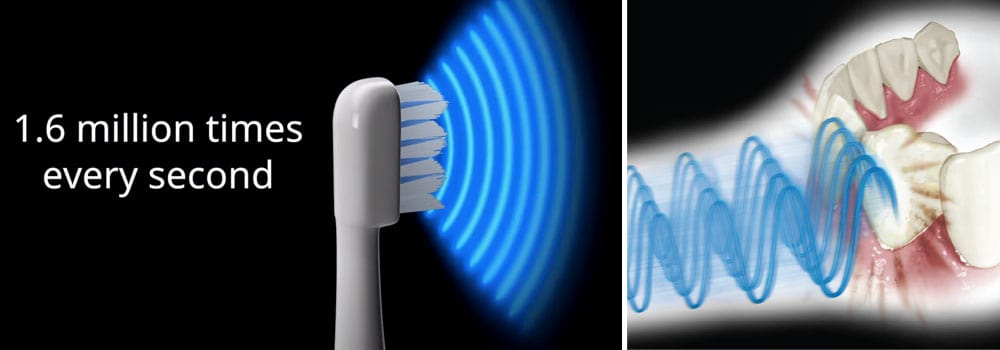
Based on how they operate and their classification, these ultrasonic brushes may also be referred to as ultrasound toothbrushes.
An ultrasonic brush compared to the more commonly seen and used sonic brushes does not need a physical motion to clean the teeth surfaces and gumline. It is also silent in operation, you won't be able to hear it.
Many ultrasonic brushes also provide additional sonic vibration (ranging from 9,000 to 40,000 movements per minute). This provides additional physical or mechanical cleaning via a sweeping motion of the bristles, this removes food particles and bacterial chain remnants.
As weird as it sounds, the addition of the sonic vibration (which can be heard) helps overcome the strange sensation of not having to brush the teeth in the way you have to with a sonic toothbrush.
An example of an ultrasonic brush is the M8S produced by Megasonex or the Emmi-dent Platinum.
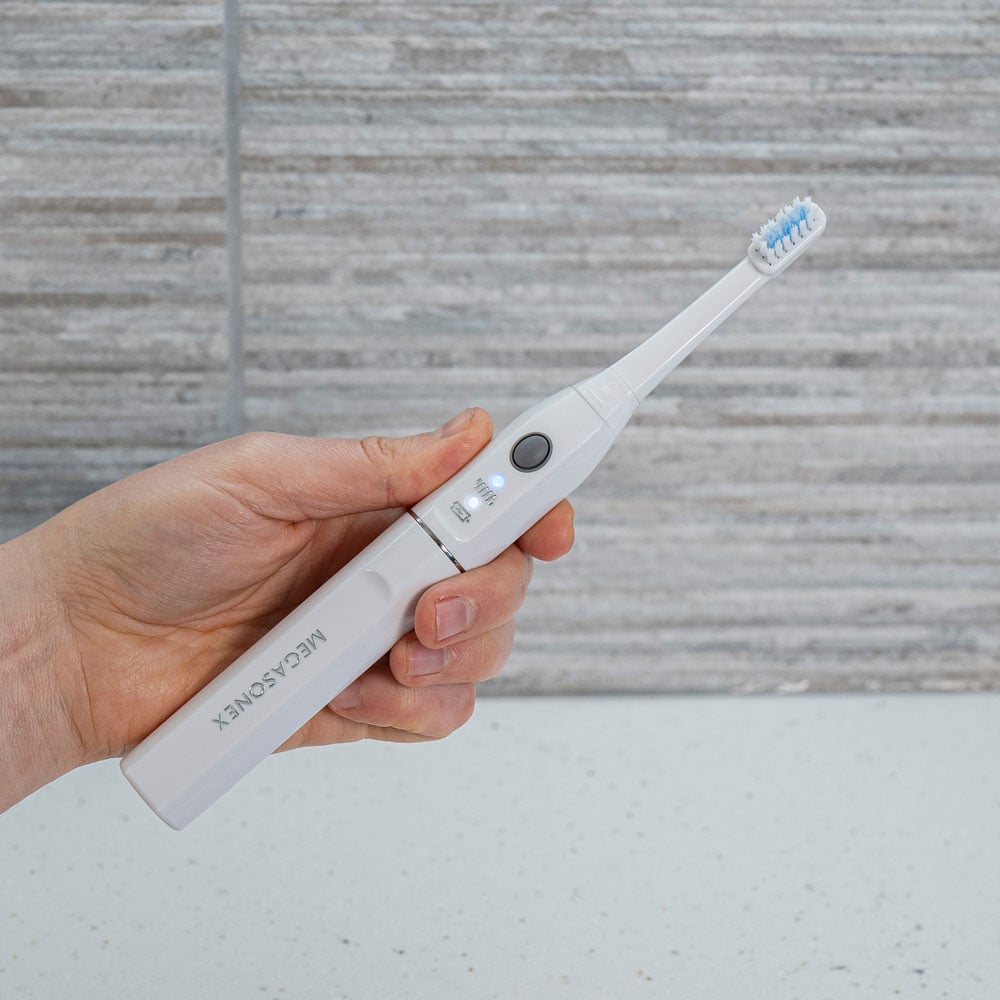
This video from YouTube gives a good explanation of what an ultrasonic toothbrush is and how it works:
Sonic vs oscillating-rotating
Sonic toothbrushes are very popular, but so are oscillating-rotating brushes.
Oscillating-rotating brushes function differently to sonic brushes.
The bristles move in a back and forth circular motion compared to the straighter back and forth sweeping motion of sonic brushes.
Whilst the 2 approaches are different, oscillating-rotating brushes do fall into the 'sonic' category. This is because the movement produces vibrations in the audible range.
It is Philips Sonicare that has made sonic toothbrushes popular and Oral-B who popularised oscillating-rotating brushes.
There is much debate as to which is better. Clinical reviews that assess all the studies have concluded that Oral-B’s cleaning action does remove more plaque. However, whether this has any real life obvious benefit is not actually known. More research is required.
The reality is that the cleaning results from either are comparable. Both approaches are backed by many dental professionals around the world. Both types of brush are more effective than manual toothbrushes when it comes to removing plaque and reducing levels of gum disease.
Our Sonicare vs Oral-B article discusses the differences between the cleaning actions and the supporting evidence in more detail.
Despite sonic brushes being very popular, it is an oscillating-rotating brush from Oral-B that is our top choice for an electric toothbrush as it delivers great cleaning results and features at a very competitive price.
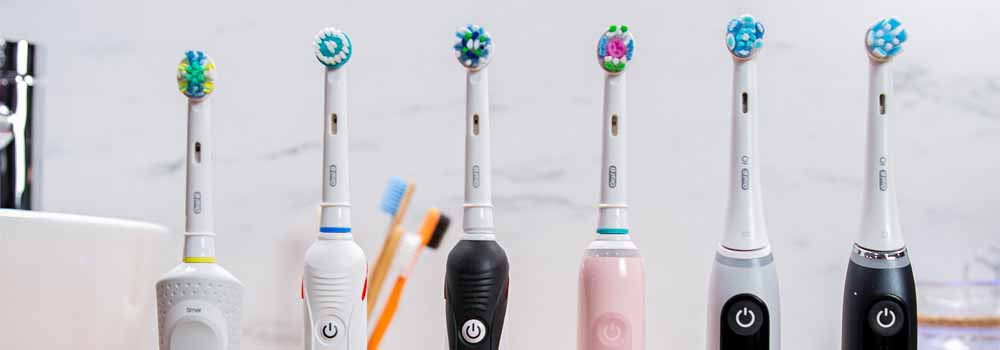
Other technology - DentalRF, Ionic power & more
The electric toothbrush and choosing one is more complicated than it really needs to be.
Many companies will cite special technology and features that make their brushes better.
There are other brushes that use additional technology. Examples of those technologies are:
- DentalRF
- Iconic power
Whilst there may well be scientific merit to each of these, as it stands none have yet proven themselves worthwhile alternatives to the conventional sonic toothbrush.
In fact, many of these products still offer a sonic cleaning action, but the technology gives an additional dimension, and improvement to the cleaning results.
These technologies are different to the ultrasonic technology which is the main focus of this article.
It is worth being aware of these though because it is very easy to get confused and misunderstand what exactly is on offer, with so many competing brands and products.
Who makes the best ultrasonic toothbrush?
Whilst ultrasonic toothbrushes have been shown on a limited scale to be effective (1 & 2) the reality is that few such toothbrushes are available to buy.
The market is dominated by sonic toothbrushes, notably those from the largest household brands.
Most ultrasonic toothbrushes still have an element of sonic cleaning. Likewise many toothbrushes marketed as sonic technology will have a small ultrasonic effect too.
There are several toothbrushes that suggest they are ultrasonic, using such words in the product title and description, but in fact, they are just standard sonic toothbrushes, operating at up to 48,000 movements per minute rather than using ultrasound to achieve the cleaning.
It is my understanding that at the time of writing, the brands who do make toothbrushes closest to being truly ultrasonic are Megasonex, Smilex and Emmi-Dent. These rely mostly or entirely on ultrasonic frequencies (with minimal sonic frequencies) so you'll be best off choosing between these if ultrasonic is what you want.
We have been hands-on with the Megasonex M8S and plan to test more in the near future.
At the time of writing, I couldn't find any of these brushes available with retailers.
Don't expect to find these in your local pharmacy, dentist's office or supermarket.
Most manufacturers ship to the USA, or you can find them on eBay.
So at this moment in time it looks like this is your best bet if you want an ultrasonic toothbrush.
If you’re not specifically looking for ultrasonic, but rather a ‘standard’ electric toothbrush, check out our post that looks at the best sonic toothbrushes.
Comparison table
To help summarise the key differences between sonic and ultrasonic toothbrushes, we've put together the following table.
| Sonic | Ultrasonic/Ultrasound | |
|---|---|---|
| Cleaning action | A physical sweeping motion is used to clean the teeth. Typically 12,000-24,000 oscillations or 24,000-48,000 movements per minute. Use high frequency waves. | No physical motion is required to clean the teeth. (Some do come with bristles for added cleaning effectiveness) 20,000Hz or 2,400,000 movements per minute. Use high frequency waves with low amplitude. |
| Noise/sound | Moderate humming sound. | Silent (ultrasound only mode). |
| Price (approx) | $20-$250+ | $150+ |
| Supporting clinical evidence | A large amount. | A limited amount. |
| Popularity & availability | High | Low |
| Common brands | Philips Sonicare Colgate SURI Oclean Oral-B | Emmi-Dent Megasonex Smilex |







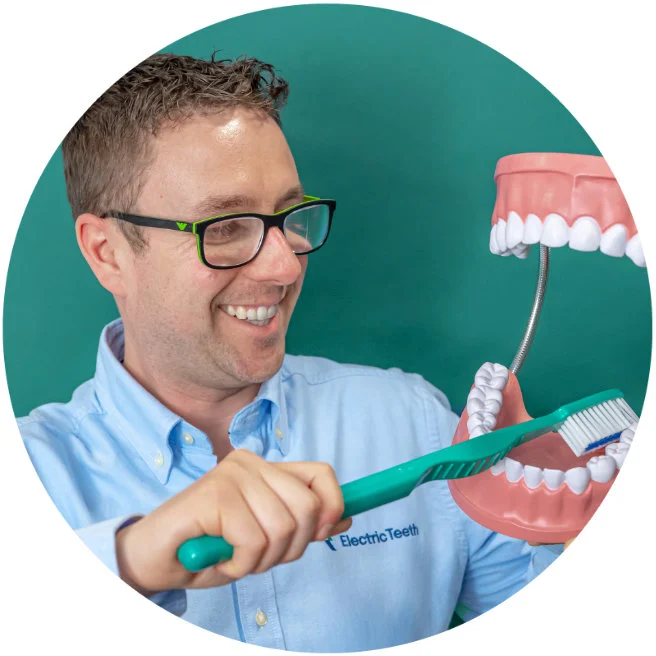
Thanks for the explanation and the differentiation between SONIC and ULTRASONIC/ULTRASOUND cleaning technologies.
FYI - the emmi-dent ultrasound device can now also be purchased on Amazon and on their US website www.emmident-ultrasound.com.
It would be worthwhile to mention the unique benefit of ultrasonic cleaning. Because ultrasound cleans touchless and without abrasive brushing there is no risk of gum damage. This is especially beneficial for people with sensitive gums/teeth, any type of gum disease (inflamed, receding gums etc.), pre-or post-oral surgery will be able to deep-clean their teeth and underneath the gum-line completely pain-free.
Thanks Frank.
Do you think the benefits of ultrasonic are worth the cost which is usually 2-3x that of a regular sonic brush for most people?
Our investigations don’t find lots of supporting clinical data to suggest the ultrasound/sonic brushes are significantly better. Of course that doesn’t mean there are not benefits just a lack of study.
I have no hard evidence but many dental professionals I believe are wary of recommending such products and moving away from the proven mechanical cleaning action sonic brushes etc bring. When many people do not actually use the correct brushing technique or brush for the right amount of time is it better or worse to encourage an approach that requires holding the brush in certain locations in the mouth?!
It is a very unusual approach/experience to not have to use a brushing motion/have the bristles and have that physical action of plaque removal.
Might you also have a vested interest to promote these products Frank as I see you are the Managing Director of Emmi-pet?
Hi Jon,
Thanks for your reply.
Replying to your comments
1) Pricing - the emmi-dent compares in pricing to other leading electric toothbrush manufacturers.
2) Clinical Research - there is European clinical research available that has been published. This research confirms that emmi-dent does remove bacterial plaque from teeth and gums without any abrasion. If of interest I can share the research papers with you.
3) Brushing Techniques - while not mentioned before the absence of the need for a brushing technique is another benefit of the ultrasound cleaning technology. To clean all you need is to hold the brush head next to the teeth. No brushing. No risk of gum or tooth damage because of a wrong brushing technique. A beep sound indicates when to move on to the next cleaning surface. No risk to hurt the gum tissue (when reading the usage instruction for electric toothbrushes you will find a statement "should not brush at one spot for more than 2 minutes". This is warning is needed because overbrushing can occur with manual brushing techniques. Such a warning is not need for the ultrasound touchless cleaning technology. Treating one spot for a longer time has actually positive health benefits by removing more bacteria, even inside gum pockets where bristles cannot reach and by increasing the gums' blood circulation - as ultrasound waves penetrate the gum tissue to help the healing process. These positive gum healing effects of ultrasound are very well documented in scientific literature.
4) Vested interest - I am indeed the representative emmi-dent for the US market, so it is of course in our interest to build awareness for a alternative cleaning technology that has advantages over traditional methods that use cleaning via abrasive action.
Have been using the Emmi-dent ultrasound toothbrush at least twice per day for 2.5 years. I have toothbrush and gingival abrasion from years of hard brushing prior to my becoming a registered dental hygienist. I absolutely love my Emmi-dent toothbrush. It cleans thoroughly and does not contribute to further erosion of my tissues. My dental hygienist says my teeth are cleaner with use of the device than when I was using a sonic toothbrush. I believe that sonic toothbrushes are also excellent devices. For certain patients though like those with abrasion, gingival/periodontal issues, oral cancer, dexterity limitations, post oral surgeries and more - ultrasound offers benefits of thorough cleaning with the absence of mechanical degradation. I am not at all concerned about any suggested side effects postulated in the comments section of this article, because the low-intensity, pulsed energy delivered has been shown safe. Jon, I hope you will test ultrasound toothbrushes to appreciate efficacy and benefits.
Thanks for the feedback Janie.
I have plans to test more ultrasonic brushes. I have a Megasonex on my desk as we speak.
Do you think the benefits of ultrasonic are worth the cost which is usually 2-3x that of a regular sonic brush for most people?
Great! Glad you will be testing ultrasound toothbrushes and look forward to your findings. I do think the benefits of an ultrasound toothbrush (the Emmi-dent Oral Waver is the only one with which I have experience) are worth the cost. Price is a huge Pandora’s box in this field. Take Philips Sonicare for example. Great toothbrushes that I used for many years. On researching price to answer your question, I noticed that various of their models deliver differing claimed levels of plaque removal. Least expensive supposedly offers 5 times more plaque removal over manual toothbrush for $49.96. (All prices in this discussion are manufactures’ published suggested retail prices on their websites as of today.) For claimed 20 times greater plaque removal, the price is $379.96. Not including bundled sets, there may be a few accessories and/or advanced technologies (ie pressure-sensing, phone app interfaces, etc), but this is the best I can declare at this time based on company website advertisements. Oral B brushes (also excellent) range from $149.99 to $249.99. Replacement 2-pack brush heads for the 2 sonic companies mentioned range from $23.74 to $32.90. Emmi-dent heads are $24.99 for a 2-pack. So you can see that the Emmi-dent toothbrush price of $219.00 is right in line with sonic products.
Another category is the quip sonic toothbrush which I have tried. It does not deliver as much energy/vibrations per minute as many other sonic devices and thorough cleaning is partially dependent on manual brushing. COMBINATION of “sonic”/“microvibratory”/“electric” and manual brushing is also offered by other companies including Philips in the $25-40 pice range, so readers should be careful when trying to compare technologies. You usually get what you pay for, and many sonic or combo products are not as advanced as others.
Now - is the cost worth it to the patient? Again, I answer a resounding “Yes” - depending on the patient and his/her needs. If one has toothbrush abrasion like I have - absolutely - ultrasound is THE way to go. Used correctly, the patient should not experience worsening erosion of enamel or gingival tissue from the cleaning device. Sonic is mechanical which will affect enamel and possibly soft tissue over time.
Other patients for whom Emmi-dent cost is justified are those with inflamed gingiva (gums) / periodontal disease (ultrasound can clean into pockets without the trauma of bristles reaching into the space), oral cancer, limited dexterity, orthodontic appliances and more. Useful also in various post-operative situations. Think about it - after oral or periodontal surgery, cleaning is necessary to prevent infection, yet touching the operative area with a brush could be painful and disruptive. An ultrasound toothbrush is held at the teeth, but no touching is required, because sound waves remove plaque.
(I have no financial interest in any dental device company.)
Thanks Janie, these comments are appreciated.
Of course, much of this is based on your experience, but do you know of or see much clinical evidence that really supports your findings? Our investigations don't find lots of supporting data. Of course that doesn't mean there are not benefits just a lack of study.
I have no hard evidence but many dental professionals I believe are wary of recommending such products and moving away from the proven mechanical cleaning action sonic brushes etc bring. When many people do not actually use the correct brushing technique or brush for the right amount of time is it better or worse to encourage an approach that requires holding the brush in certain locations in the mouth?!
It is a very unusual approach/experience to not have to use a brushing motion/have the bristles and have that physical action of plaque removal.
Jon, I apologize for not answering one of your questions above. You mentioned that many people do not use correct brushing technique - so true. I believe it is better to require less dexterity and less technique than not. Although it is a change from an in-grained habit, holding the toothbrush is much easier than performing a prescribed technique. You just have to give it a chance and concentrated effort in the beginning. Soon with practice, the different way of doing anything becomes more comfortable.
Use the brush according to direction and check success with disclosing solution. Do the same with other methods/devices. Try to conduct a fair study comparison with similarly dirty teeth, attention to performing correct technique in the correct amount of time according to the device at hand. (Flossing is still recommended with ultrasound as it is with sonic, combination sonic/manual and manual brushes.)
I do not know if Megasonex and Emmi-dent deliver the same amount of ultrasound energy but am certain that you can discover specifications.
Hi Jon, excellent questions and points. I agree that further study is need on ultrasound toothbrushes. The concept of cleaning by sound waves is foreign to many people and education is in order. Advertising could also help ultrasound’s cause tremendously to raise awareness and educate. The costly nature of both are unfortunately prohibitive at this time. You are correct in that holding a brush and allowing it to do the work is different than manual brushing, but if you think about it, a sonic toothbrush does the work on its own too. The sonic toothbrush actually moves and over time abrades tissue through mechanical contact, while the ultrasound relies on sound waves to destroy bacteria.
I retired from dental hygiene practice many years ago and embarked on a medical device sales career. For the past 20:years, I sold a low-intensity, pulsed ultrasound bone stimulator to heal fresh fractures quickly and heal non healing fractures to completion. So although sound waves are channeled differently in various devices (including imaging devices like fetal ultrasound, intraocular depth gauges (invented by my ex-husband/friend), fish finders and a plethora of other ultrasound modalities), the concept of cleaning by ultrasound is exciting to me, as I understand the science. I apologize, but because I do not currently practice dental hygiene, I am not able to offer clinical data regarding ultrasound toothbrushing.
My sister has epilepsy and significant essential tremors. She loves her Emmi-dent ultrasound toothbrush, as she stabilizes her elbow on the countertop and holds the brush at a section of teeth until she hears a times beep to move to the next section. Again anecdotally, her hygienist is impressed that she is brushing so well and says that her teeth are very clean.
I saw a video of the Emmi-dent President saying that the device is very helpful in removing plaque from dental implants. As you know, bacteria can attach to the implant material, especially around the screw portion. Ultrasound is an effective way to remove it with no harm to the implant. Recently saw Russian studies declaring that sonic and ultrasound toothbrushes (Emmi-dent and sonic devices were included in the study) were more effective than manual brushing.
I generally see the Dentist every four months (due to plaque buildup and gum disease.) I got a Smilex through Amazon about six years ago...But, they seem to have gone Under. The brush heads are supposed to last three months. Brushing 4x/day, however, it's more like two months (at Most.) I can still find replacement heads on eBay, but they are Expensive. I had a Great checkup after I started using the product, but, then, I changed several different parameters. I began using a special Chlorine mouthwash, and Livioniex (a Dental gel that chelates calcium.) I still use the gel, and started the mouthwash again.
I am trying to find an electric toothbrush where the least vibration would be felt.
Ah, at last, an intelligent, hype-free explanation of the "ultrasonic" toothbrush market. Having spent my career in the ultrasonic cleaning industry, I still only knew enough about this teeth cleaning stuff to not get it (most people don't know enough about the tech to face that challenge). So I get it, and I will take your objective advice and replace my oscillating toothbrush with a "sonic" rather than ultrasonic one. Twice daily with an ultrasonic implement at a "cavitational" (sub-100kHz) frequency seems like it might be a bit harsh on thin enamel over time. At "megasonic" frequencies it should be alright - then again, cleaning efficacy at that frequency comes into question. So, anyway, thank you Jon.
Do you have any knowledge as to whether the ultra sound technology is safe to use every day. How does it compare to ultrasound used for example in the hospital for pregnancies etc.
Also could this be used instead of going for a full under the gum cleaning/planing where they have to freeze you in order to get the plaque below the gum line. How long would it take to accomplish what a 3 hours session of deep cleaning /planing would take?
Esther. I have to admit my lack of knowledge here. I can't give you a precise answer without taking time to research this in detail and consult with dental professionals.
This is not medical/dental advice, but as I understand it they are safe to use every day.
I do not believe this could replace any deep cleaning that you would have done at a dentist's office.
Thank you. Someone on your thread did mentioned the concern about ultra sound so that is why i asked about safety so wondering if there was any way to find information to understand how this ultrasound technology is different from what is used in the hospitals. I guess it would have to be FDA approved so then we wouldn't need to worry?
I guess it would be a good preventative to not have to go through a deep cleaning again!
Have you heard of CariPRO toothbrushes? It claims to be an ultrasonic toothbrush, but I am not sure based on the description. Do you have any experience with those?
I have heard of them, but have yet to test. I am sceptical as to whether they are ultrasonic. As far as I can tell (without going hands-on) they are Sonic toothbrushes, like Sonicare. I cant help but think the lack of detail on their product page explaining their technology is a clear sign that they might not be what they claim.
Are these ultrasonic toothbrushes (Megasonex, Smilex, and Emmi-Dent) foreign electric toothbrushes (european/asian) requiring a different frequency (electrical connection) for operation or charging?
Potential Thomas. It depends on which brand and where you buy it from. All being well the seller should state if this is the case. Some will support the voltage, just require a plug adapter.
I absolutely love this article. I have an electric toothbrush and was looking around for something better. I heard a bit about ultrasonic toothbrushes and was close to being suckered into buying a high powered electric toothbrush that was simply titled "ultrasonic" instead of being a true ultrasonic toothbrush.
If someone else reading this is looking for some more clinical study information about the benefits of ultrasonic toothbrushes...
"It is challenging to assess the efficiency of different toothbrushes, as there are so many factors contributing to the removal of plaque and the maintenance of oral hygiene. Nevertheless, published data indicate that ultrasonic, as well as electric toothbrushes, maintain better oral hygiene than manual counterparts. By direct comparison of different toothbrushing systems, most clinical trials show that the sonic/ultrasonic toothbrushes perform better than purely non-acoustic powered brushes. Sonic/ultrasonic toothbrushes may have the potential to reduce more dental biofilm by stimulating more hydrodynamic effects and also by forcing more efficient brushing motions."
https://www.ncbi.nlm.nih.gov/pmc/articles/PMC7175112/
The article further goes into a lot of meticulous detail and clinical findings, with cited sources.
Thank you again for writing such an informative article.
I am desperately looking for a NON ULTRA SONIC ELECTRIC TOOTHBRUSH.
I DONT WANT THE ONE THAT SOUNDS LIKE A BUMBEL BEE HIGH PITCH SOUND.
I HANE BAD SINUS PROBLEMS , WAKE UP FROMA FAN OR A/C WITH THE WHOLE HALF OF MY UPPER TEETH OR LOWER TEETH LIKE A DUALING HEADACHE BUT HURTING LIKE 6-7 teeth.
I want a old first kind they came out with that didn’t BUZZ . It just went up and down very rapidly and recharged back up each day in its holder. Can’t use a high pitch Buzzing Sonic . Can you help me find this kind.
I already bought two different brands with multi speeds, pulse, massage but the SONIC Vibration still hurt. Threw them away. Mine was dropped in the bath room ink with water that went down too slow. Now it is real slow on a full charge. Can you direct me somewhere? Is thee companies who may hac
Be older stock left over? Thank you. please reply ASAP
Pat Boyd.
Your best option for silent/no vibration cleaning will be the emmi-dent ultrasonic toothbrush. They have versions where sound and vibration can be turned off - for a completely silent and vibration-free cleaning experience. Also they have a patented cleaning technology that is clinically proven to remove bacterial plaque. Emmi-dent can be found on Amazon, Ebay and their company website www.emmident-ultrasound.com
Hi Pat.
Thanks for the comment.
Sonicare electric toothbrushes are not ultrasonic, but from what you say this too might not be suitable. What brands of brush have you actually tried?
What toothbrush did you use before?
I do not know your sinus problems and am not trained in this field to make a qualified comment, but perhaps a manual toothbrush might be appropriate, given that all toothbrushes produce some form of vibration and buzzing sound.
Do you have a consultant/doctor you are in contact with about your sinus issues that could advise based on your personal circumstances?
Do you know anything about the Mira Pet toothbrush for dogs? They advertise their product as an ultrasound brush which also includes a vibration setting. I would like to know if it is a true ultrasound toothbrush. Thank you.
Hi Karen.
We have not investigated pet toothbrushes, so I have not come across or used the Mira Pet toothbrush.
A quick look at their website doesn't reveal much useful information. However, it does say 60 million oscillations per minute which would imply it was actually ultrasonic.
Yes - Mira-pet does use ultrasound for cleaning and so does emmi-pet (from the makers of the emmi-dent ultrasonic toothbrush).
Different to all other brands, the emmi-pet technology is patented and clinically proven to remove bacterial plaque.
I too want to purchase one but am not finding any in the US
However I am pretty sure that a US type charger will work well maybe
Hi Brandy.
Was there a particular brand or model you were after?
I know emmi-dent are sold on Amazon.com
Thank you sooo much for this information, I was searching just for this for at least 2 years now.
If I would buy one, I'd definitely go for sonic. Ultrasound destroys also beneficial bacteria in mouth, which is bad for health - long term. Also Russian researchers have recently experimented with ultrasound a little bit. Ultrasound actually silence our DNA and we have actually not even a remote idea what would this mean for future generations (especially coz it's used for watching the vulnerable fetus in womb, not to mention using it every day in our head / mouth).
must use special toothpaste?
No. Normal toothpaste is fine.
Megasonex is available in the UK on Amazon.co.uk
I wonder if there are any studies that determined if there is a higher risk of brain tumors with the ultrasonic machines?
I am not aware of such studies specifically in relation to brain tumors. I believe some studies have looked at the effects of the electromagnetic fields of such devices.
Hello Jon,
thank you for the great overview and toothbrush technology comparison.
Please allow a couple comments.
At least for one Ultrasonic toothbrush Emmi-dent, there is ample evidence of the effectiveness. Several clinical studies conducted in Germany by the University of Witten-Herdecke confirm the effectiveness of Emmi-dent in cleaning away harmful bacterial plaque. Different to other Ultrasonic devices, Emmi-dent's patented Ultrasound piezo-chip is embedded right behind the bristles, closest to teeth and gums to maximum cleaning effectiveness. Importantly, and not mentioned in the article, are the fundamental technology advantages of Ultrasound vs. ordinary cleaning by brushing:
1) Zero abrasion and most gentle cleaning - because there is not brushing action and ultrasound toothpastes do not contain abrasive particles. Hence, teeth and gums are cleaned most gentle. Abrasion is a serious dental care challenge - often driven by wrong brushing techniques, and leading to receding gums and exposed tooth rootshttps://en.wikipedia.org/wiki/Abrasion_(dental) . Cleaning with Ultrasound eliminates this risk.
2) The 2nd big advantage over bristle cleaning is reach. Ultrasound generates millions of nano-size cleaning bubbles that reach into the tiniest crevices, gum pockets, fissures, behind braces and ultrasound waves are even penetrating the gums. Thereby, Ultrasound kills and cleans away bacteria in areas bristles cannot reach.
Last not least the good news that Emmi-dent is now available in the USA, with USA specification (110 Volt and power plug) - and I know this because I am the new distributor for Emmi-dent products in the US and Canada. :-)
I hope this clarifies a bit the differences between abrasive mechanical brushing and gentle ultrasound cleaning. If you need any more information, I'd be happy to provide it to you.
BR
Frank Dreier
Would like to buy a real ultrasonic toothbrush in the US.
Would like more information about the Emmi-dent ultrasonic toothbrush to purchase in Canada. How can I get in contact with you? On facebook I can be messaged under Esteri Ruth.
I am interested in purchasing this emmi dent US toothbrush...pls contact me.
Please tell me more about the Emmident Ultrasound toothbrush! Thanks!
Please send me more info on this ultra sonic toothbrush and who sells it.
Thank you